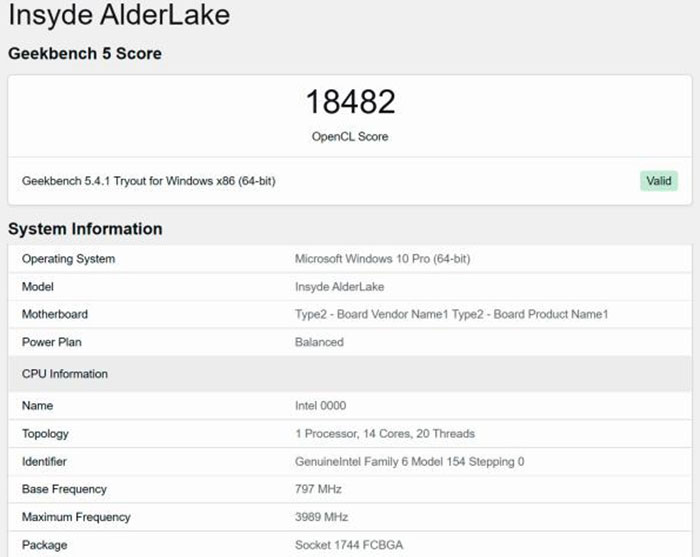Intel DG2, this variant has performance equal to a GeForce GTX 1050

Intel DG2
Two benchmarks were recently published on the Intel DG2 GPU, which indicate performance similar to that of NVIDIA's GeForce GTX 1050. One of the benchmarks (reported by Leakbench) concerns the standalone version, while the other (as indicated by Benchleaks) probably refers to the integrated solution on the 12th generation Alder Lake CPUs. Insyde, a renowned UEFI manufacturer, has run the tests, giving them some credibility, but we still recommend that you take into consideration that the results obtainable from the final versions may vary due to drivers, thermal limits and other factors that could affect performance.The first test highlights the use of a dedicated video card with 256 Execution Unit (EU) and a maximum frequency of 1,400MHz. The specifications correspond to those of one of the alleged variants of DG2. Although the rumors were about 8GB of GDDR6 memory, in reality on Geekbench 5, where the card scored 18,482 points in the OpenCL benchmark, 6.22GB is reported. According to the official Geekbench 5 ranking, the GeForce GTX 1050 is capable of reaching a score of 18,230-18,895. Therefore, the performance of the DG2 is equivalent to the Pascal architecture based graphics card.
The second test found a DG2 GPU with only 96EU and a maximum clock speed of 1,200MHz. Given the amount of EU and memory (1.5 GB), it is easy to deduce that it is an integrated GPU. Even before this benchmark, there were already rumors that Intel was putting the DG2 GPU inside its Alder Lake-P chips. This variant scored 6,516 points, so its performance is slightly below that of a GeForce GTX 460.
Both DG2 GPUs have been spotted alongside a 14-core, 20-thread Alder Lake processor, so we suspect this is the mobile model (Alder Lake-P). The FCBGA package tells us that Insyde is likely working on a system validation platform (SVP), which is essentially a desktop motherboard.
Alder Lake-P CPU reportedly has a 797MHz base clock and a boost clock of 3,989MHz. The drastic change in clock speeds is due to the hybrid design with Golden Cove and Gracemont cores. The fact that Insyde is already validating Alder Lake's support on its products shows that Intel's new line is doing well. Indeed, Alder Lake is very close to arriving on the market as external manufacturers, such as Insyde, do not have access to the hardware until the last stages of development.
We will not know if Alder Lake can compete with the best. CPU until its official launch. Intel hasn't confirmed a specific date, but we expect a debut in late 2021 or early 2022.
Looking for a new PSU to power your next GPU? Corsair RM750X, 750W modular power supply, is available on Amazon.
Intel DG2-256EU benchmark puts it in GeForce GTX 1050 territory
A week ago HEXUS reported upon some leaked benchmark results which gave some indication of the likely performance of Intel's upcoming DG2 graphics cards based upon the Xe-HPG GPU. Last week's info regarded a GPU with 448EUs – and it went shoulder-to-shoulder with the likes of the AMD Radeon RX 6700 XT and Nvidia GeForce RTX 3070 according to those figures.

Just ahead of the weekend, some other Twitter-based benchmark data miners unearthed evidence of some smaller GPUs on their way to the DG2 stables. Leakbench found what is likely to be a discrete GPU of some kind with 256EUs, a top frequency of 1.4GHz, accompanied by 6.22GB of VRAM. Benchleaks made note of what is likely to be an integrated GPU with 96EUs at a maximum of 1.2GHz, alongside 1.5GB of VRAM. Both results featured Intel Alder Lake CPUs, and the graphics were based upon the 'Gen12 GPU' architecture from Intel, according to the benchmarking tool reports. Sadly, both sets of results have now been taken down, but the likes of Tom's Hardware and VideoCardz have captured the Geekbench data for posterity.

Indications are that the GPU with 256EUs is based upon a cut down DG2-384 GPU, and that it was installed in a laptop because the accompanying CPU was installed in a 'FCBGA 1744' socket. Performance wasn't great in this instance, with the Geekbench score of this 256EU GPU recorded as 18450 points – on a par with a GeForce GTX 1050 graphics card. Of course the 96EU GPU with slower clocks and less VRAM did even worse, with scores on a par with something like the GeForce GTX 460.
Last week's leaks from Tum Apisak had pitched an Intel DG2-128EU GPU as being faster than the GeForce GTX 1650, so the latest results from what appear to be mobile / integrated implementations are quite disappointing. However, the indication that these latest scores do come from early, power-restrained, laptop implementations should help enthusiasts and gamers stay positive about the upcoming Intel raid into mainstream desktop PC gaming GPU territory.